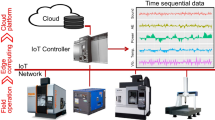Abstract
In the milling process, a rotating cutting tool is used to cut the raw material into the desired shape. Since tool breakage adversely affects productivity, real-time tool breakage detection is required. In this study, a tool breakage monitoring system using AE signals and a deep learning model was investigated. First, LSTM-Autoencoder was constructed and trained using the AE signal, cutting speed, spindle speed, and depth of cut as input data. In order to distinguish between tool normality and anomalies, the largest value among the normal cutting data set was determined as the threshold to determine if the tool was broken. As the result of the experiment, we obtained the accuracy of 82.1% during normal cutting, but the accuracy was significantly reduced to 63.1% and 63.6% at the time of entry/exit. This is because the AE value that occurs during normal entry/exit is so large that it is mistaken for breakage. To overcome this problem, a combined model that uses both LSTM-Autoencoder and Gaussian Mixture Model was developed. First LSTM-Autoencoder was used to determine the breakage, and then Gaussian Mixture Model was used to determine the authenticity of the breakage. As a result of the experiment using the developed model, 52 out of 57 cuttings including entry/exit cutting were detected as failures, showing a high reliability of 91.2%, proving the superiority of the combined model.








Similar content being viewed by others
References
Cho, S., Asfour, S., Onar, A., & Kaundinya, N. (2005). Tool breakage detection using support vector machine learning in a milling process. International Journal of Machine Tools and Manufacture, 45(3), 241–249.
Hesser, D. F., & Markert, B. (2019). Tool wear monitoring of a retrofitted CNC milling machine using artificial neural networks. Manufacturing Letters, 19, 1–4.
Neslušan, M., Mičieta, B., Mičietová, A., Čilliková, M., & Mrkvica, I. (2015). Detection of tool breakage during hard turning through acoustic emission at low removal rates. Measurement, 70, 1–13.
Sun, S., Hu, X., & Zhang, W. (2020). Detection of tool breakage during milling process through acoustic emission. The International Journal of Advanced Manufacturing Technology, 109(5), 1409–1418.
Li, W., & Liu, T. (2019). Time varying and condition adaptive hidden Markov model for tool wear state estimation and remaining useful life prediction in micro-milling. Mechanical Systems and Signal Processing, 131, 689–702.
Hochreiter, S., & Schmidhuber, J. (1997). Long short-term memory. Neural computation, 9(8), 1735–1780.
Cho, K., Van Merriënboer, B., Gulcehre, C., Bahdanau, D., Bougares, F., Schwenk, H., and Bengio, Y., 2014, Learning phrase representations using RNN encoder-decoder for statistical machine translation, arXiv preprint arXiv:1406.1078.
Malhotra, P., Ramakrishnan, A., Anand, G., Vig, L., Agarwal, P., & Shroff, G., 2016, LSTM-based encoder-decoder for multi-sensor anomaly detection, arXiv preprint arXiv:1607.00148.
Hao, G., and Kunpeng, Z., 2020, Pyramid LSTM auto-encoder for tool wear monitoring, IEEE 16th International Conference on Automation Science and Engineering, CASE, pp. 190–195.
Hundman, K., Constantinou, V., Laporte, C., Colwell, I., and Soderstrom, T., 2018, Detecting spacecraft anomalies using lstms and nonparametric dynamic thresholding, In Proceedings of the 24th ACM SIGKDD international conference on knowledge discovery & data mining, pp. 387–395.
Liu, W., Cui, D., Peng, Z., and Zhong, J., 2019, Outlier Detection Algorithm Based on Gaussian Mixture Model, IEEE International Conference on Power, Intelligent Computing and Systems (ICPICS), pp. 488–492.
S.L. Hahn, 1996, Hilbert Transforms in Signal Processing, Artech House, s.l., p. 305
Nho, Y.-H., Rtu, S., & Kwon, D.-S. (2021). UI-GAN: Generative Adversarial Network-Based Anomaly Detection Using User Initial Information for Wearable Devices. IEEE Sensors J., 21(8), 9949–9958. https://doi.org/10.1109/JSEN.2021.3054394
Acknowledgements
This work was supported by the 2018 Research Fund of the University of Seoul.
Author information
Authors and Affiliations
Corresponding author
Additional information
Publisher's Note
Springer Nature remains neutral with regard to jurisdictional claims in published maps and institutional affiliations.
Rights and permissions
About this article
Cite this article
Nam, J.S., Kwon, W.T. A Study on Tool Breakage Detection During Milling Process Using LSTM-Autoencoder and Gaussian Mixture Model. Int. J. Precis. Eng. Manuf. 23, 667–675 (2022). https://doi.org/10.1007/s12541-022-00647-w
Received:
Revised:
Accepted:
Published:
Issue Date:
DOI: https://doi.org/10.1007/s12541-022-00647-w




